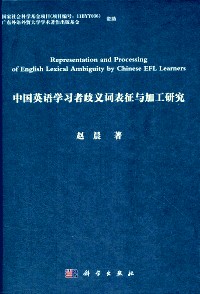
Representation and processing of English lexial ambiguity by Chinese EFL learners
副标题:无
作 者:赵晨著
分类号:
ISBN:9787030341228
微信扫一扫,移动浏览光盘
简介
《中国英语学习者歧义词表征与加工研究》从词汇语义表征形成与发展的角度,探讨了中国英语学习者在词汇表征建构的不同阶段、词汇多义不同纬度(三种歧义词)的通达特征。研究发现,中国英语学习者的歧义词表征是一个发展的模式:同形歧义词和转喻多义词的心理表征随学习者英语水平的提高而更具分立性;但在转喻多义这个维度上,词义之间的联系强度不是随着语言水平的提高而减弱,而是相反。就不同歧义词的通达特征而言,中国英语学习者通达三种歧义词的特点相同,都遵循顺序通达模式。这充分体现了基于用法理论的语言学习观。
目录
前言
Abstract
Chapter 1 Introduction
1.1 Research Orientation
1.2 Definition of Lexical Ambiguity
1.3 Rationale for the Study
1.4 Research Questions
Chapter 2 Previous Studies of Lexical Ambiguity Resolution: General Issues
2.1 Introduction
2.2 Meaning Representation
2.2.1 Hierarchical Network Models
2.2.2 Activation Spreading Models
2.2.3 Distributed Memory Model
2.3 Word Recognition and Lexical Access
2.3.1 The Search Model
2.3.2 The Logogen Model
2.3.3 The Cohort Model
2.3.4 Factors Influencing Lexical Access
2.4 Semantic Priming
2.5 Second Language Lexicon
2.6 Summary
Chapter 3 Previous Studies of Lexical Ambiguity Resolution: Theoretical Models and Empirical Evidence
3.1 Introduction
3.2 Previous Studies of Homonymy Processing in L1
3.2.1 Fodor's Modularity Hypothesis
3.2.2 Five Models of Homonymy Processing in L1
3.3 Previous Studies of Suppression Mechanism in Homonymy Processing
3.4 Previous Studies of Homonymy Processing in L2
3.5 Previous Studies of Polysemy Processing in L1
3.5.1 Representation of Polysemous Words
3.5.2 Previous Studies of Polysemy Effects
3.5.3 Processing of Polysemy in L1
3.6 Previous Studies of Polysemy Processing in L2
3.7 Comments on the Previous Studies of Lexical Ambiguity Resolution
3.8 Summary
Chapter 4 Previous Studies of Lexical Ambiguity Resolution: Experimental Tasks
4.1 Introduction
4.2 Experimental Techniques
4.2.1 Ambiguity Detection Method
4.2.2 Processing Complexity Tasks
4.2.3 Priming Paradigm
4.3 The Nature of Sentential Context
4.4 The SOA Conditions
4.5 Comments on the Experimental Tasks
4.6 Summary
Chapter 5 Research Questions and Hypotheses
5.1 Introduction
5.2 Linguistic and Psycholinguistic Models Related to the Present Study
5.2.1 Ambiguous Words in Mind: Linguistic Models
5.2.2 Disambiguation of Lexical Ambiguity: Psycholinguistic Models
5.3 Research Questions
5.4 Hypotheses
5.5 Experimental Design and Predictions
5.5.1 Experiment One
5.5.2 Experiment Two
5.5.3 Experiment Three
5.6 Summary
Chapter 6 Experiment One: Selecting Contextually Appropriate Meanings
6.1 Introduction
6.2 Preparatory Studies
6.2.1 Preparatory Study Ⅰ
6.2.2 Preparatory Study Ⅱ
6.2,3 Preparatory Study Ⅲ
6.3 Experiment One
6.3.1 Hypothesis, Design and Predictions
6.3.2 Participants
6.3.3 Materials
6.3.4 Procedure
6.3.5 Results
6.3.6 Discussion
6.4 Summary
Chapter 7 Experiment Two: Suppressing Contextually Inappropriate Meanings
7.1 Introduction
7.2 Experiment Two
7.2.1 Hypothesis, Design and Predictions
7.2.2 Participants
7.2.3 Material
7.2.4 Procedure
7.2.5 Results
7.2.6 Discussion
7.3 Summary
Chapter 8 Experiment Three: Representation of English Lexical Ambiguity
8.1 Introduction
8.2 Experiment Three
8.2.1 Hypothesis, Design and Predictions
8.2.2 Participants
8.2.3 Materials
8.2.4 Procedure
8.2.5 Results
8.2.6 Discussion
8.3 Summary
Chapter 9 General Discussions
9.1 Introduction
9.2 Discussion of Lexical Ambiguity Resolution Theories
9.2.1 L2 Processing of Homographs: The Ordered-Access Model
9.2.2 L2 Processing of Metonymic Polysemy: Specified, Not Underspecified
9.2.3 Comparison of the Processing of Different Ambiguous Words
9.3 L2 Lexical Ambiguity Resolution and Reading Comprehension
9.4 Summary
Chapter 10 Conclusions
10.1 Introduction
10.2 Conclusions
10.2.1 Conclusions about the Experiments
10.2.2 A Unified Picture for L2 Resolution of Lexical Ambiguity
10.3 Limitations and Suggestions for Future Studies
10.3.1 Limitations
10.3.2 Suggestions for Future Studies
10.4 Implications
10.4.1 Theoretical Implications
10.4.2 Pedagogical Implications
10.5 Summary
Bibliography
Appendices
Appendix A: Ambiguous Words for Judgment
Appendix B: A Sample of Materials Used in Preparatory Study Ⅱ
Appendix C: Dominance and Familiarity of the Ambiguous Meanings
Appendix D: Primes with Sentential Contexts and Their Targets
Appendix E: The Sense Relatedness Questionnaire
Representation and processing of English lexial ambiguity by Chinese EFL learners
- 名称
- 类型
- 大小
光盘服务联系方式: 020-38250260 客服QQ:4006604884
云图客服:
用户发送的提问,这种方式就需要有位在线客服来回答用户的问题,这种 就属于对话式的,问题是这种提问是否需要用户登录才能提问
Video Player
×
Audio Player
×
pdf Player
×


